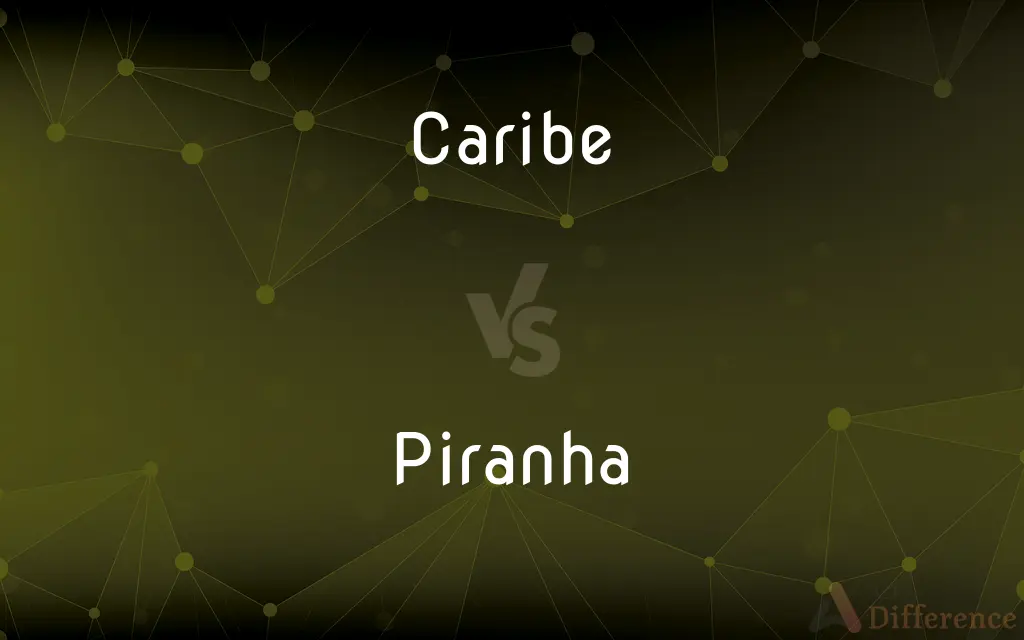Caribe vs. Piranha — What's the Difference?
By Fiza Rafique & Maham Liaqat — Updated on May 6, 2024
Caribe fish are often confused with piranhas due to their similar appearance and aggressive nature, but differ primarily in their geographical distribution.

Difference Between Caribe and Piranha
Table of Contents
ADVERTISEMENT
Key Differences
Caribe, often referred to as pirambeba, are a subgroup of piranhas, belonging to the family Serrasalmidae, found predominantly in the Orinoco and Amazon basins in South America. While piranhas, which also belong to the same family, are more widely recognized and are distributed across a broader range of South American rivers.
Caribe are particularly noted for their aggressive behavior and a slightly more elongated body shape. Whereas piranhas are typically more robust with a reputation for a ferocious bite, often depicted in media and folklore.
The diet of Caribe often consists of fish, insects, and other small aquatic creatures, highlighting their role as pivotal predators in their ecosystem. On the other hand, piranhas have a more varied diet, which can include plants and fruits, depending on the species and environmental conditions.
In terms of size, Caribe generally reach about 20 inches in length in their natural habitats, making them formidable in size. In contrast, many piranha species usually grow to about 6 to 10 inches, with some exceptions reaching up to 18 inches.
Reproduction among Caribe involves laying eggs in pits dug during the rainy season and can be quite prolific. Meanwhile, piranhas often exhibit similar reproductive behaviors but environmental factors like water temperature and availability of food can influence their breeding patterns more significantly.
ADVERTISEMENT
Comparison Chart
Geographical Distribution
Mostly found in Orinoco and Amazon basins
Found across various South American rivers
Body Shape
Elongated body
More robust, compact body
Diet
Predominantly fish, insects, and small creatures
Varied, including plants and fruits
Size
Up to 20 inches in length
Generally 6-18 inches, depending on the species
Reproduction
Eggs laid in pits during the rainy season
Similar, influenced more by environmental factors
Compare with Definitions
Caribe
Known for their elongated body shape compared to other piranhas.
The elongated body of the Caribe helps it maneuver quickly through water.
Piranha
Known for their powerful jaws and sharp, triangular teeth.
The piranha's bite is strong enough to cut through tough flesh.
Caribe
A freshwater fish native to South American rivers, known for its aggressive nature.
The Caribe is often mistaken for a piranha due to its sharp teeth and predatory behavior.
Piranha
A common name for several omnivorous fish species in the Serrasalmidae family in South American rivers.
Piranhas are often featured in sensational stories about river monsters.
Caribe
Predators that play a significant role in their ecosystem by controlling other fish populations.
Caribe help maintain the ecological balance by preying on weaker fish.
Piranha
Generally smaller than Caribe, with most species reaching 6 to 10 inches.
Despite their smaller size, piranhas are effective in groups.
Caribe
Members of the Serrasalmidae family, primarily inhabiting the Orinoco and Amazon basins.
Caribe have adapted well to the dynamic environments of the Amazon.
Piranha
Their diet includes fish, plants, and even larger animals when available.
Piranhas occasionally feed on fruits that fall into the water.
Caribe
Can reach up to 20 inches in length in wild conditions.
The large size of the Caribe can be intimidating to other species in the river.
Piranha
Reproductive habits influenced by environmental conditions like water temperature.
Piranhas are more prolific breeders when conditions are optimal.
Caribe
See piranha.
Piranha
A piranha or piraña (, , or ; Portuguese: [piˈɾɐ̃ɲɐ], Spanish: [piˈɾaɲa]), a member of family Serrasalmidae, or a member of the subfamily Serrasalminae within the tetra family, Characidae in order Characiformes, is a freshwater fish that inhabits South American rivers, floodplains, lakes and reservoirs. Although often described as extremely predatory and mainly feeding on fish, their dietary habits vary extensively, and they will also take plant material, leading to their classification as omnivorous.
Caribe
Piranha fish
Piranha
Any of various tropical American freshwater fishes of several genera, especially Serrasalmus and Pygocentrus, that have sharp teeth and are known for attacking and feeding on live animals. Also called caribe.
Caribe
A south American fresh water fish of the genus Serrasalmo of many species, remarkable for its voracity. When numerous they attack man or beast, often with fatal results.
Piranha
(ichthyology) Any of the carnivorous or frugivorous freshwater fish living in South American rivers and belonging to the subfamily Serrasalminae.
Caribe
Small voraciously carnivorous freshwater fishes of South America that attack and destroy living animals
Piranha
Someone who attacks in search of booty
Piranha
Small voraciously carnivorous freshwater fishes of South America that attack and destroy living animals
Common Curiosities
What are Caribe?
Caribe are a subgroup of piranhas, known for their aggressive behavior and found mainly in the Amazon and Orinoco basins.
What type of environment do Caribe prefer?
Caribe thrive in freshwater river systems, particularly in the murky waters of the Amazon and Orinoco river basins.
What are common misconceptions about Caribe and piranhas?
A common misconception is that both are man-eaters, but attacks on humans are rare and usually occur in extreme situations like starvation.
How do piranhas differ from Caribe in terms of diet?
While both are carnivorous, piranhas have a more diverse diet that can include plants and fruits.
Are piranhas more dangerous than Caribe?
Both are considered dangerous due to their sharp teeth and feeding habits, but piranhas have a more notorious reputation.
How do Caribe and piranhas impact their ecosystems?
Both play crucial roles as predators, helping control populations of other fish and thus maintaining the ecological balance.
Can Caribe be as large as piranhas?
Yes, Caribe typically grow larger than many piranha species, reaching up to 20 inches.
What is the social behavior of Caribe compared to piranhas?
Caribe are often seen schooling, especially in their juvenile stages, similar to piranhas, which are known for forming large groups.
Do Caribe and piranhas have similar breeding habits?
Both species lay eggs, but Caribe tend to breed during the rainy season, laying eggs in pits, whereas piranhas' breeding can be more influenced by environmental conditions like water temperature.
How do locals view Caribe compared to piranhas?
In their native regions, both Caribe and piranhas are respected for their potential danger, though piranhas may carry a more fearsome reputation globally due to popular culture.
What are some distinctive features of piranhas?
Piranhas are known for their sharp, triangular teeth and powerful jaws, which are capable of a powerful bite.
Are there any conservation concerns regarding Caribe and piranhas?
While not generally endangered, some species within these groups may face threats from habitat destruction and pollution.
What research is being conducted on Caribe and piranhas?
Research often focuses on their behavior, dietary habits, and ecological roles, as understanding these factors is crucial for riverine ecosystem management.
Can Caribe and piranhas be kept in aquariums?
Yes, but due to their aggressive nature and potential size, keeping them requires specific conditions and is generally recommended for experienced aquarists.
Share Your Discovery

Previous Comparison
Gene vs. Cistron
Next Comparison
Lap vs. LegAuthor Spotlight
Written by
Fiza RafiqueFiza Rafique is a skilled content writer at AskDifference.com, where she meticulously refines and enhances written pieces. Drawing from her vast editorial expertise, Fiza ensures clarity, accuracy, and precision in every article. Passionate about language, she continually seeks to elevate the quality of content for readers worldwide.
Co-written by
Maham Liaqat












































